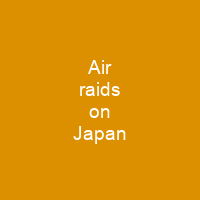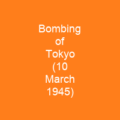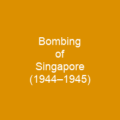The Pacific War: Air Raids on Japan
During the Pacific War, Allied forces conducted extensive air raids on Japan from 1942 to 1945, killing between 241,000 and 900,000 people. Strategic bombing raids began in June 1944 and continued until August 1945. The US Army Air Forces campaign against Japan intensified during the war’s last months. B-29 bombers used a combination of high-altitude daylight and low-altitude night firebombing tactics to target urban areas. The bombings, combined with atomic bombs dropped on Hiroshima and Nagasaki in early August 1945, led to Japan’s decision to surrender.
Strategic Planning and Early Raids
The Allied bombing campaign began in earnest in mid-1944 after the US Army Air Forces developed contingency plans for an air campaign against Japan during the early years of the Pacific War. The first American Volunteer Group was formed in late 1941 to attack Japan from bases in China using medium bombers, but it did not become active due to the Pearl Harbor attack. Japanese successes during the opening months of the Pacific War nullified US plans for attacks against the Japanese homeland.
Technological Advancements and Tactics
The Allies used a variety of tactics, including precision bombing and firebombing, which were largely ineffective until the development of new technologies such as the B-29 bomber and atomic bombs. The bombings also led to fuel shortages, inadequate pilot training, and a lack of coordination between units, which constrained the effectiveness of Japan’s fighter force.
Operation Matterhorn: Preparations and Challenges
In late 1943, the United States Joint Chiefs of Staff approved a proposal to begin the strategic air campaign against the Japanese home islands and East Asia by basing B-29 Superfortress heavy bombers in India and establishing forward airfields in China. This strategy involved constructing large airstrips near Chengdu in inland China which would be used to refuel B-29s traveling from bases in Bengal en route to targets in Japan.
Japanese Countermeasures
The Japanese military transferred fighter aircraft to the home islands from China and the Pacific in early 1944 in anticipation of B-29 raids. By late June, air defense units in the home islands had 260 fighters and could draw on approximately 500 additional aircraft during emergencies. The Japanese government sought to improve civil defenses, directing households to build their own shelters and expanding firefighting forces.
Firebombing Campaigns
The USAAF resumed its raids on the Kuril Islands in February 1944 after being reinforced with P-38 Lightning escort fighters. XX Bomber Command began flying missions against Japan in mid-June 1944, but initial raids caused little damage. The first American attack against Japan was codenamed Operation San Antonio I, targeting the Musashino aircraft plant on November 24, 1944. The attack caused some damage and further reduced Japanese confidence in their air defenses.
Operation Meetinghouse: Tokyo’s Devastation
In response to the attack, the IJAAF and IJN stepped up air attacks on B-29 bases, resulting in the destruction of 11 Superfortresses and damage to another 43. Japanese aircraft also launched Fu-Go balloon bombs against the US during November. The next American raids on Japan were not successful. XXI Bomber Command attacked Tokyo three times between 27 November and 3 December; two of these raids were made against the Musashino aircraft plant while the other targeted an industrial area using M-69 incendiary cluster bombs.
Firebombing Successes
The Imperial General Headquarters adopted a civil defense plan in late January 1945 to counter American air raids. Civilians were assigned responsibility for fighting fires and observing a blackout from 10:00 pm. By March 1945, USAAF commanders were concerned about the failure of these campaigns and believed that they made it difficult to justify the high costs of the B-29 program.
Atomic Bombings
In 1943, USAAF planners began assessing the feasibility of a firebombing campaign against Japanese cities. Japan’s main industrial facilities were vulnerable to such attacks as they were concentrated in several large cities and a high proportion of production took place in homes and small factories in urban areas. The USAAF tested the effectiveness of incendiary bombs on Japanese-style buildings and developed ‘bat bombs,’ but these projects were abandoned.
Conclusion
The air attacks on Japan caused hundreds of thousands of casualties, with estimates ranging from 333,000 killed to 1.3 million wounded. The destruction of buildings housing government records contributed to uncertainty about the number of casualties. Much of Japan’s industrial capacity was destroyed or badly damaged, contributing to a decline in production and economy. The air attacks also caused extensive damage to urban areas, destroying approximately 40% of the area in 66 cities and rendering over 2.5 million housing units unusable. 5 million people homeless.

You want to know more about Air raids on Japan?
This page is based on the article Air raids on Japan published in Wikipedia (retrieved on November 28, 2024) and was automatically summarized using artificial intelligence.







